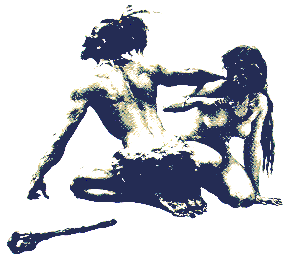 Steve Trussel
Steve Trussel
Facts or Authors? |
| For the natural scientist, listening to a lecture in the field of the humanities can grow into a tantalizing experience. What would you say if, during a seminar at the history department, the claim was raised that all our culture arose from bad conscience over a parricide committed in prehistoric times? This bold claim was originally raised by Sigmund Freud (Totem und Tabu 1913). Presumably you would - as I did - not believe your ears, unless you did have some knowledge on psychoanalysis before. |
| According to his biographer Ernest Jones, Totem and Taboo was one of Freud's favorite œuvres. Based on anthropological literature on savages in Australia, Africa, Malaysia, Melanesia and Polynesia, Freud meant to see a correspondence between the psychology of “primitive peoples” and the psychology of neurotics. Freud modified Darwin's Primal Horde hypothesis postulating that early humans lived in small groups in which the dominant male prevented sexual promiscuity, jealously keeping all the females for himself and driving away his sons as they grew. |
| It has to be suspected that Freud's (and Darwin's) knowledge about primate behavior was rather limited at their times. Their "primal horde" is reminiscent of gorillas (but see Bradley et al. 2005) rather than of human beings (and gorillas still lack some of the more advanced refinements of human culture). Also our closest relatives, the chimpanzees, do not exhibit a social behavior that would fit into this image of extreme male dominance. Among primates, those taxa expressing minimal male-male competition also exhibit low levels of sexual dimorphism (Larsen 2003), and humans and chimps range at the lower end of this scale. According to a recent study, also our ancestor Australopithecus afarensis (the most famous representative being 'Lucy') more than 3 million years ago was at this lower end (Reno et al. 2003; a conclusion recently challenged by Plavcan et al. 2005; but see defense by Reno et al. 2005). |
| As a natural scientist, you would try to confront the psychoanalysis followers with that more recent knowledge, wouldn't you? At least I tried so with, however, very poor results. All I was told was, that I shouldn't rely to much on singular results and that, all in all, the contributions of anthropology, archeology, and genetics to the elucidation of the evolution of our social behavior were meagre. Right before I started to protest, I remembered where I was: At the department of history, right in the middle of a bunch of history students. And here, the seminar was not on the evolution of culture; no, it was on the œuvre of Sigmund Freud. Once more I realized the main source of misunderstanding between natural scientists and scholars in the humanities: The first ones deal with facts, and the other ones with - authors. |
| B.J.Bradley, M.M.Robbins, E.A.Williamson,
H.D.Steklis, N.G.Steklis, N.Eckhardt, C.Boesch, L. Vigilant (2005) Montain
gorilla tub-of-war: Silverbacks have limited control over reproduction in
multimale groups. PNAS 102: 9418-9423.
C.S.Larsen (2003) Equality for the sexes in human evolution? Early hominid sexual dimorphism and implications for mating systems and social behavior (commentary). PNAS 100: 9103-9104. J.M.Plavcan, C.A.Lockwood, W.H.Kimbel, M.R.Lague, E.H.Harmon (2005) Sexual dimorphism in Australopithecus afarensis revisited: How strong is the case for human-like pattern of dimorphism? J Hum Evolution 48: 313-320. PL.Reno, R.S.Meindl, M.A.McCollum, C.O.Lovejoy (2003) Sexual dimorphism in Australopithecus afarensis was similar to that of modern humans. PNAS 100: 9404-9409. P.L.Reno, R.S.Meindl, M.A.McCollum, C.O.Lovejoy (2005) The case is unchanged and remains robust: Australopithecus afarensis exhibits only moderate skeletal dimorphism. A reply to Plavcan et al. 2005. J Hum Evolution 49: 279-288. |
| Nevertheless, I dove into an e-mail dispute with Evelyne List, the host of the seminar. |
| Read
more
about Freud's 'Totem and Taboo' in The
Literary Encyclopedia Read more on 'The Possible Origin of Culture' by Andy Lock (2002) Human Nature Review 2: 195-203 |